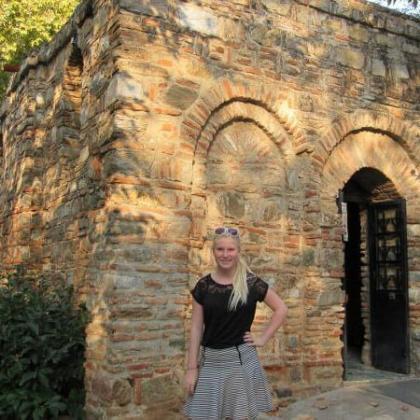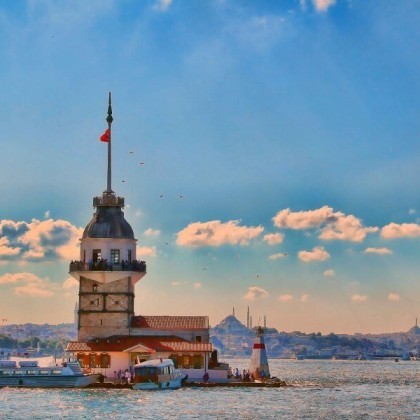Malatya
Malatya (pop. 800,000) is Turkey’s apricot capital and birthplace of Turkey’s second president. The city lies in a fertile basin, shadowed by a barren range that points the way to the magnificent Nemrut Dagi ruins. While most approaches are unremarkable, the journey from the south (Adana or Maras) is characterized by cascade carved gorges. Malatya’s football team, which has only recently joined Turkey’s top tier, is the latest jewel in the crown of this glittering modern city. Malatya’s open parks and wide, tree-lined boulevards are as pleasant to stroll through as the narrow corridors of its famous apricot bazaar.
Most travelers arrive in Malatya’s palatial otogar, 3km west of town. Dolmuş connect this station with downtown, passing the train station on the way.
Istanbul New Year’s Eve Party Cruise on the Bosphorus
IstanbulWith this new year's eve party program in Istanbul, you will have an amazing new year party on the Bosphorus. Book it now and don't miss the special price!
View Tour3 Days Ephesus, Pergamon and Pamukkale Tour Package
Ephesus, Pamukkale, PergamonIf you want to make an amazing trip to the Ephesus, Pergamon, and Pamukkale, you should read our tour itinerary.
View TourIstanbul and Cappadocia Tour – 7 Days
Istanbul, Cappadocia, TurkeyIf you want to make a trip to Istanbul and Cappadocia both, we strongly suggest you join this amazing package tour. This tour covers all the accommodations, transportations, lunches...
View TourBest of Turkey Package Tour – 8 Days
Istanbul, Cappadocia, Ephesus, PamukkaleAre you looking for a good traveling package in Turkey? With our 8-days Turkey tour, you will make a trip to every important sight in Turkey. Enquire now for...
View Tour- Flights: Cem Tour, 11/1 Galleria İş Merkezi (322 66 66; fax 322 84 44), just west of the main square, sells THY tickets. Bus service meets each flight and departs from multiple downtown locations 2hr. before departure, sometimes for a fee. THY flies regularly to Ankara, Bodrum, İstanbul, İzmir, and international destinations.
- Buses: Regular dolmuş link the town center and the otogar ($.20). A taxi costs $2-3. To: Adana (6hr., 3 per day, $9); Adiyaman (3hr., 6 per day, $6); Ankara (10hr., 6 per day, $18); Antakya (Hatay) (7hr., 3 per day, $10); Diyarbakır (4hr., 3 per day, $6); Doğubeyazıt (15hr., 4 per day, $14); Erzurum (8hr., 3 per day, $11); Gaziantep (4hr., 6 per day, $6); İstanbul (16hr., 6 per day, $20); Kahramanmaraş (3/2hr., 3 per day, $3); Kayseri (5hr., 2 per day, $9); Konya (10hr., 2 per day, $16); Mersin (7hr., 4 per day, $10); Sivas (4hr.,10 per day, $6); Trabzon (15hr., 2 per day, $13); and Van (9hr., 2 per day, $12). Companies offer shuttles from downtown 30min. before departure. Trains: The station (324 77 70) is located 1km west of the statue on Atatürk Cad. The istanbul-Ankara line and the Adana line run to Malatya. 2 trains run daily to: Adana, Ankara, and İstanbul.
- Car Rental: Meydan Rent A Car (325 13 17; fax 323 47 03), 1km west of the town center, rents relatively new Fiats for under $30 per day, with unlimited mileage. A few days is enough to take in Nemrut Dağ, Diyarbakır, Mardin, Midyat, and Şanlıurfa by car.
ORIENTATION AND PRACTICAL INFORMATION
Malatya’s main street, İnönü Cad., runs parallel to the Ankara-Van highway and turns into Atatürk Cad. on the other side of the İnönü statue at the town center. The statue faces a series of tea gardens that cascade downhill to the market streets, including the famous coppersmith’s and apricot bazaars. Hotels, restaurants, banks, and the PTT are all within a five-minute walk from the İnönü statue.
- Tourist Office: Vilayet Binası Kat. 1 (323 30 25; fax 324 25 14), on the 1st floor of the Vilayet Hall. English spoken by Bülent, Kemal and Sabrı. If the office is closed, try the çay garden in the rear of the building. Open M-F 9m-noon, 1-5pm. Tours to Nemrut Dağı depart daily at 11:30am from behind the town hall, in the parking lot next to the tea garden. The $30 fee includes summit lodging at the Güneş Motel, dusk then dawn at the site, 2 meals and transport. At the time of writing, however, the Güneş Motel was closed for renovations, and transport-only tours were arranged for $10-15. Hitching or local transport is not advisable due to the remoteness of this location.
- Travel Agencies: Cem Tour (see “Flights”) offers more expensive tours ($150-$250), including the Atatürk Dam, Huran and Old Ufa. Open daily 8am-8pm.
- Banks: Many major banks are in the main square. All are open M-F 8am-noon, 1:30- 5:30pm. Traveler’s checks can be exchanged at Türkiye İş Bankasi and TC Ziraat. Hospital: English is spoken at the central, private Sergi Yip Markezi (325 98 88) on Atatürk Cad. The state-run Devlet Hastanesi (326 15 70) and the private Turgut Özal Hastanesi (341 06 60), 17km toward Van, both offer 24hr. care.
- Post Office: The main PIT (322 34 25) is 30m down a small alley off the northwest corner of the main square. Open 8am-noon,1:30-5:30pm; 24hr. card phones are here and along İnönü Cad.
ACCOMMODATIONS AND FOOD
Among Malatya’s budget picks, Park Otel , 17 Atatürk Cad., 100m east of the square, is a clean, well-lit place with 24hr. hot water. The back rooms are quieter except during the call to prayer, (321 16 91. Singles $6; doubles and triples $10.) For similar digs in a darker setting, Otel Tahran O, along PTT Cad., has simple rooms, private bath, hot water, phones, and a communal kitchenette, (321 36 15. Singles $5; doubles $8; triples $12.) Claustrophobes should avoid Otel Ozen , across the street at PTT Cad. 18 (321 1770), unless $6 doubles suppress symptoms. Hotel Yeni Sinan , 6 Atatürk Cad., is the best of the mid-range, with spacious rooms and good bathrooms. (»321 29 07. Singles $10; doubles $15.)
Mangal Vadisi (326 22 00), on Kisla Cad., just off Atatürk Cad., boasts “cook-your-own” Anatolian food in private grill-pits. The menu is familiar, but the kebaps are tasty and rich in vegetables ($2-3). Closer to the center, the Çinar 2001 Kebap Salonu O, 37 Atatürk Cad. (»322 54 81) offers excellent chicken sote and a variety of pizzas to go with their own array of kebaps ($1-2). Right in the town center, Blue Bell’s Sandwich Cafe, No. 9 Atatürk Cad., delivers faster food and freshly- squeezed orange juice. After dinner, a stroll down the tree-lined and Fuzuli Cad. (on the right off Atatürk Cad., 460m from the İnönü statue) will take you past ice cream and dessert spots. Birinci Pastanesi, halfway to the museum, has particularly sumptuous offerings, ( 322 19 52. Open daily 7am-lam.)
SIGHTS
Malatya’s glass and steel facades offer little in the way of classical architecture, but its shaded trees hold numerous outdoor restaurants and çay gardens, the largest. of which is Kernek, at the end of the promenade on Fuzuli Cad. Here, one can promenade with the locals or dine at the Kemek Şelalesi ve Park Restaurant (323 93 61), which offers cheap food, a view over the entire park, and a water garden.
In the bazaar district, sprawling north and east from the Malatya Büyük Otel, vendors peddle everything from head scarves to metal work. Its famous fresh and dried kayisisi (apricots) are purveyed in the fantastic apricot market. Apricot, raisin, and nut enthusiasts will be stuffed beyond their wildest dreams with handfuls of nuts, candies, and various forms of dried fruit. Couches and tea are provided to help you munch your way through the samples. The nearby coppersmith’s and produce markets are also remarkable. In addition, a roving bazaar sets up tables in different city neighborhoods every day, offering local clothing and perishable goods. The kilim and carpet bazaar is on İnönü Cad., opposite the statue, with cheaper car-pets than in western Turkey. Near the Malatya Büyük Otel, dusty male travelers can enjoy a Turkish bath in the 125-year-old Belediye Hamam. (Bath $2; kese $4. Open daily 5am-9pm.) Women can go to the similarly-priced Saray Palace, 100m behind the Belediye building. Malatyaspor, the beloved local football team, is a big deal in town, and games are held every Friday, Saturday, and Sunday from August until the end of May. Tickets should be purchased early on the day of the game at the stadium, on the opposite end of Fuzui Cad. from the Kerack museum.
Just over 10km away, the town of Battalgazi and apricot groves now cover what would have once been Eski Malatya (old city of Malatya). Now only the city walls and the 13th-century Ulu Camii remain. The ancient Hittite site of Aslantepe can be reached 4km northeast of the city; contact the tourist information office upon arrival. Aslantepe (“Lion Hill”), is best visited in July and August, when the archaeological teams from Rome are actively excavating. Buses to both destinations leave from the dolmuş lot on the highway 500m north of the town center.
HEAD OF HİS TIME
Antîochus’s tomb lies buried beneath a man-made mountain of rubble, guarded by towering stone statues. Locked for centuries inside the peak of Mount Nemrut, this burial site, described as the eighth wonder of the ancient world, was discovered in 1881. Since then it has continued to thwart archaeologists and modem investigative technology, with its delicate structure likely to collapse and crush any attempt to burrow toward its possible secrets and treasures. The king has so far clung to his treasures through both might and wile: he put not just heavy bricks in the way, but also Turkish bureaucrats. Denied access to the tomb itself, archaeologists have contented themselves with interpretation of the site’s sandstone reliefs, among them, possibly the world first horoscope, dating precisely to Antiochus’ coronation in 109 BC. Particularly resounding are the texts of Nemrut’s many inscriptions, all told in the eerily familiar first-person of Antiochus himself:
Therefore, for this monument a foundations secure from the ravages of time I planned to prepare. In it my body, as it had existed blessedly until old age, after to the heavenly throne of Zeus Oromasdes my divinely loved soul has been sent forth, will sleep for endless eternity.
In the 20th century, archaeologists’ dynamite and increased tourist traffic have upped the ante, meaning that the ravages of time may be gaining the upper hand. Exposed again to the elements, reliefs are beginning to erode; propped-up statues have toppled again under the weight of winter snow. In addition, visitors run amok over the barricade-free site. Though there is talk of restoration efforts, locals are specials. Only five years ago, a toppled head was restituted for the ludicrous sum of 6 million lira ($10,000). Locals offered to complete the same task with 20 tourists, ten minutes, and a blanket, but to no avail. Perhaps red tape is the one thing that will ensure Nemrut remains as it is for decades to come.
NEMRUT DAĞI
Accessible from Malatya Kahta, Adiyaman, and Şanlıurfa . The site is at the base of a cone-shaped pile of rocks, at the bottom of which are three terraces on the north, west, and east. Open during daylight hours. $3.50, students $2. The Malatya road ends 100m below the eastern terrace, while the road from Kahta ends in a parking lot 1 km from the summit. Beside the parking lot is Nemrut cafeteria, offering 24hr. food, drinks, and a bathroom. Allow at least 2hr. to explore the site, including the walk up. Rough winds can cause chills and dehydration: bring layers and water.
Upon the highest peak in the region (2150m), King Antiochus I ordered the construction of a 75m pyramid of rubble, flanked by massive statues, their heads long since decapitated by earthquakes (most recently 1938) and time. At. dawn and dusk, solitude and silence prevails on this impressive funerary monument, the calm broken only by the whipping of a constant wind.
The site holds relics dating back to the Commagene kingdom, a border kingdom which managed to fend off the Romans and Persians encroaching from either side between 162 BC and 72 AD. The kingdom was greatest under Antiochus, son of Mithradates, who claimed direct ancestry to Alexander the Great on his father’s side and to the Persian Darius the Great on his mother’s, thus embodying the unification of east and west in one royal line. Antiochus is best remembered for installing a brand new pantheon of syncretic gods like “Apollo-Mithras” and “Zeus Oromas des.” He commissioned 10m high statues of these gods in their honor; they are seen bestowing the divine mandate upon a 10m statue of himself. The Herculean labor of constructing this shrine from six-ton stone blocks (not to mention a 75m tall peak (now eroded to 50m) of crushed rock now thought to hide the tomb itself) leads archaeologists to think it may rival Tutankhamen’s for wealth and majesty. Meanwhile, the collection of 3m tall stone heads continues to attract visitors to the site. These gargantuan, fallen from the shoulders of crumbled statues, recall Shelley’s “Ozymandias.”
Careful observation can match fallen heads to the torsos above. The figures on the eastern (sunrise) platform are identical to those on the west (sunset) side, and there is a rough symmetry from left to right: lion, eagle, Apollo-Mithras, Zeus Oro masdes, Antiochus, Herades Aragnes, eagle, and lion. Sunrise and sunset show the site at its most glorious; they also draw massive crowds of Turkish and foreign tourists alike. For a less-crowded snapshot, the site is usually deserted in the middle of the day, and the statues are just as impressive.
If you plan a trip to Nemrut Dağı, you will need to stay in a nearby town. Malatya (p. 498) and Şanlıurfa are probably the better options, as they are pleasant cities in their own right. Kahta and Adiyaman are reasonable bases as well. The bus company Adiyaman Ünal ((416) 2161112) arranges fast day tours to Nemrut Dağı from Adiyaman. Kahta is an oil-town with a dusty main street and a few incongruous 4-star hotels. Nonetheless, it is the closest major town to Nemrut Dağ, and is the best way to see the other surrounding sights within the national park, such as the Roman bridge at Cendere and the bas reliefs of Eski Kaleb and Yeni Kale, all accessible from the Malatya side.
Most hotels offer for $7-10 per person, and will offer day tours to Nemrut Dağı (short $28-40 per minivan; long $40-60 per minivan; minivans hold 10-12 people). Nemrut closes from first snowfall (Nov.) until mid-April, though winter walking toms can be arranged. Jandarma clear the site after dusk and enforce a nonclimbing policy on the unstable rubble pyramid.





